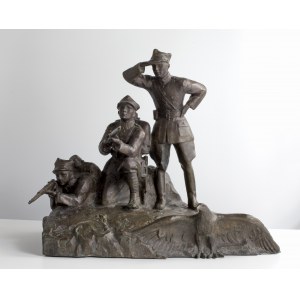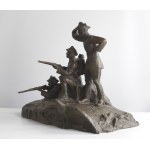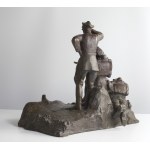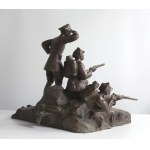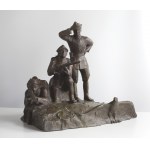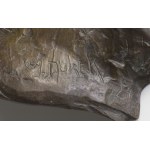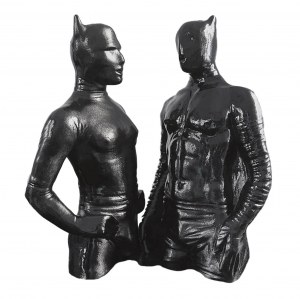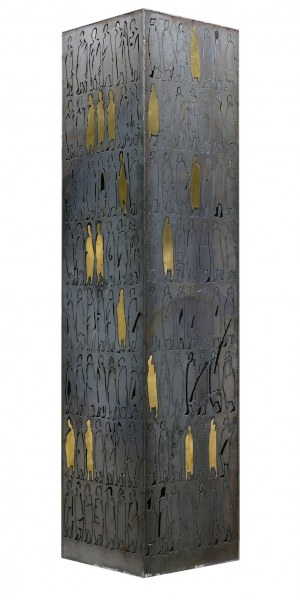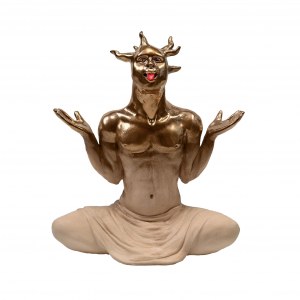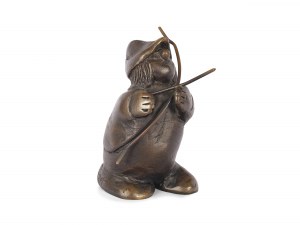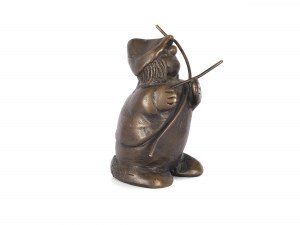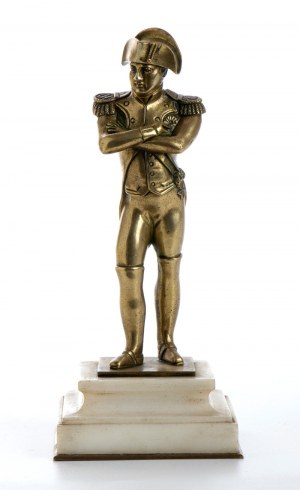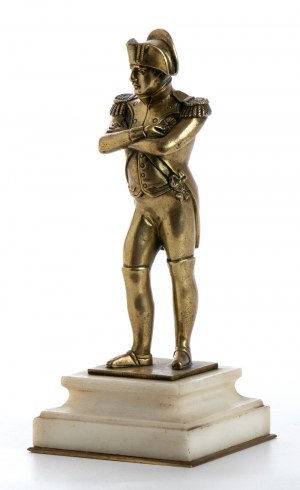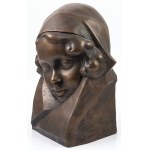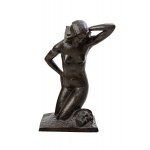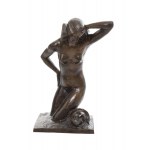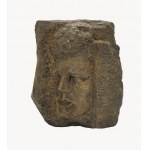44.0 x 53.0 cm - cast bronze, chiseled, patinated bronze, cast, patinated, 44 x 53 x 38 cm
Signed on underside: WA DUREK | 924, BCIA ŁOPIEŃSCY | WARSAW.
In the 1920s, bronzes with military themes occupy an important place in the Lopienski Brothers' assortment. These range from small figurines of soldiers to large, elaborate compositions, usually ordered for specific occasions, not infrequently as a gift to Jozef Pilsudski. The company's archives indicate that there were quite a few of these productions, but the vast majority were destroyed during World War II. The works that have survived to this day are a rarity, among them is undoubtedly the sizable figure of the Riflemen, a hitherto unknown work by Wojciech Durek. The excellent quality bronze, in addition to its artistic value, undoubtedly also has museum value as a work indicating the cooperation of the best Polish bronze company with one of the best-known sculptors operating in Torun, whose works appear extremely rarely on the art market.
Wojciech Durek, next to Ignacy Zelek, was considered the most outstanding artist of the 1930s in the Pomeranian province. Durek, a representative of Symbolism and Neorealism, created mainly monumental and religious sculptures. Among his best-known creations was a monument created in 1923 in honor of the fallen soldiers of the 8th Torun Sappers Regiment in Torun, while a lesser-known but impressive work was the monument to the Miracle on the Vistula River in Pelplin, destroyed in 1939. This very dynamic composition shows a group of legionaries led by Jozef Pilsudski, with a white eagle spreading its wings over them. They are facing Red Army soldiers, who, seized with fear, fold their banners in front of Pilsudski. It should be mentioned here that the motif of soldiers and eagle very often appears in Polish art with military themes during the Second Republic, and it is also present in Strzelce. This sculpture is also characterized by frontality, imposing a central point of view, to which Durek, as a representative of the Milanese school of Medard Rosso, subordinated his works. The excellent, vivid composition, the summary but not unrealistic modeling, as well as the casting, devoid of the smallest imperfections, superbly worked and covered with a light bronze patina - all make the offered work a great example of high quality bronze, which was created as a result of cooperation between a sculptor proficient in his subject matter and some of the best bronzers in Europe.
Wojciech Aleksander Durek (Mala, 1888 - Kielce 1951) - sculptor and painter. He studied at the Higher Industrial School in Cracow, then - at the vocational school in Laas, Tyrol, and at the Accademia di Belle Arti in Milan, from which he graduated in 1911. In 1915 he served his sculpture apprenticeship in Graz (1915). Between the wars he lived in Torun, where he was a member of the local Artists' Confraternity, founded on the initiative of Julian Fałat. In 1921-1928, together with Ignacy Zelk, he ran an atelier called Atelier Rzeźba in Torun, on Sukiennicza Street, which offered designs and execution of sculptures and applied art to furnish churches and residential interiors. At the end of the 1920s the artist left Torun, while in 1945 he settled in Kielce, where he died.
The first show of his works took place at the Legions Exhibition organized by the Society of Friends of Fine Arts in Cracow in 1920. In the following years he showed his works in Warsaw (1920), Torun (1922, 1928), Bydgoszcz (1924), Lublin (1931), Kielce (1945, 1949), among others.
He created monumental and religious sculptures, often realized in concrete. His best known works are: the statue of Christ the King in the market square in Chojnice (1931), the bas-relief in the chapel of the Virgin Mary in Chelmza (ca. 1932), the monument in honor of the fallen soldiers of the 8. Torun sapper regiment in Torun (1928, destroyed in 1939), a monument to Stanislaw Moniuszko in Torun (1923, dismantled in 1928), a sculptural complex on the grounds of the garrison in Komorowo (1932-1933), depicting Polish leaders, kings and heroes of the November Uprising and Stanislaw Moniuszko, sculptures for the 12 chapels of the Calvary in Wielu (1915-1924), commemorating the victims of World War I, concrete sculptures in the bishop's park in Pelplin (1937, Group of St. Adalbert, Miracle on the Vistula River, and St. John the Baptist. Adalbert, Miracle on the Vistula, two groups - a total of 10 figures - of Pomeranian bishops), sculpture of Christ the King in Mała )1935-1936), monument to those murdered in 1939 in Chelmza. He was also involved in medal making, and was awarded 3rd prize in a competition for a medal of the first Sejm of the Republic of Poland after regaining independence. He also made decorations for church interiors (including the church in Wielu) and painted portraits and religious scenes.
His works are in the collections of the District Museum in Torun, the Leon Wyczółkowski Museum in Bydgoszcz, and the Theater Museum in Warsaw.
Recently viewed
Please log in to see lots list
Favourites
Please log in to see lots list



